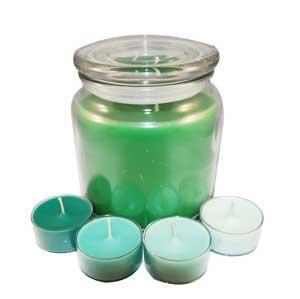 When it comes to candle making, the wax you use is really up to personal choice.
When it comes to candle making, the wax you use is really up to personal choice.
There are quite a few reasons why candle makers select soy wax for their candles. Some like it due to the fact that soy wax is 100% natural (it is a pure vegetable wax) and it is biodegradable. Many prefer soy wax because of the long, even, and clean burn the wax provides with less soot. And, even still, many candle crafters like soy wax because it is an environmentally friendly, renewable resource that American farmers can plant and harvest; also helping the economy too. Some other reasons for why some people prefer using soy wax for their candles are ease of use. Since this wax is in flake form, it is a breeze to weigh out, work with, and clean up. And, soy wax is a single pour wax, requiring no repours.
Soy wax is for container candles. Due to the nature of this natural wax, the finished candle will have a mottled (or frosted) appearance on top. However, if you do not like this appearance, you can always apply heat to the finished candle with a hot hair dryer or heat gun.
Supplies and Equipment Needed:
NG 100% Soy Wax
Fragrance Oil
Spectrum Candle Dye or Color Block
Pouring Pot
Thermometer
Glassware
Wicks
Scale
Stainless steel mixing utensil
Cookie Sheet
Hot Glue Gun
Glue Sticks
Stove
Pot
A little behind the scenes knowledge:
For this candle making process we are going to suggest the double boiler system for melting the wax. Fill a large pot half way full with tap water. Place the filled pot onto the stove top burner. Turn the appropriate burner on medium heat. Once you have the pouring pot filled with the correct amount of soy wax, place the pouring pot into the water filled pot. Once the water starts to boil, you will notice that the soy wax is beginning to melt. As this occurs, you want to occasionally stir the wax to ensure an even temperature.
Carefully place your glassware on a cookie sheet. Preheat your oven to the lowest temperature possible. Once the oven is heated, place the cookie sheet with the glassware into the oven. Allow your glassware to warm in the oven for 10-15 minutes. Once the allotted time has passed, carefully remove the cookie sheet using oven mitts. Set these aside.
The standard fragrance percent for soy candles is 1-1 ½ ounces of fragrance oil per pound of wax.
For measuring purposes, 20 ounces (weight) of soy wax is equivalent to 16 ounces of fluid volume.
Directions for making a soy candle:
1. Weigh out the correct amount of soy wax with your scale.
2. Place your soy wax into your pouring pot and using the double boiler system, heat the wax to 185 degrees Fahrenheit. Monitor this by using your thermometer. Please Note: Heating soy wax hotter than 200 degrees Fahrenheit will discolor the wax, so proper monitoring of the temperature is advised.
3. While you are waiting on the wax, plug in your hot glue gun.
4. Once the wax is in a liquid state, add your candle colorant.
5. Next, add your Natures Garden’s fragrance oil of choice and stir well to incorporate throughout the wax.
a. For this step you will need to know the flashpoint of the fragrance oil you selected. The right temperature is extremely important to ensure that the fragrance oil binds properly with the soy wax. You also do not want to risk “burnoff”. Burnoff is the adding of a fragrance oil at too hot of a wax temperature. Because a flashpoint on a fragrance oil is the highest temperature the fragrance can handle before breaking down, burnoff can affect the scent in the finished candle. That is why you want to know the proper temperature to add the fragrance oil. You can find this information right on the label of the Natures Garden fragrance oil. This information is also in the Important Fragrance Specifics area on the website under each fragrance oil listing.
b. Fragrance Flashpoints give you the answer as to when you add your fragrance oil to the hot wax. Any flashpoint that is higher than 185 degrees Fahrenheit is added at 185 degrees. For any flashpoints that are below 185 degrees, they should be added at or below the flashpoint degree. The key to remember is try not to add the fragrance oil at a temperature that is hotter than its flashpoint.
c. Some fragrance oils have a very low flashpoint. In these cases, testing comes into play. You are balancing flashpoint temperatures with the fact that the wax needs heat in order to bind the scent with the wax.
6. Once the soy wax has been scented and colored, you will want to stir your wax thoroughly. Doing this step will help the mixing and binding of the color and scent throughout the wax.
7. The next step is allow your soy wax to cool at room temperature. Place your thermometer into the pouring pot and wait until the wax reaches 110 degrees Fahrenheit. Pouring at this temperature will allow for a smoother surface in your finished candle. While you are waiting, prep your containers for the pour.
8. Using your hot glue gun, place a little amount of glue to the bottom of the wick tab. Then, carefully center the wick to the bottom of the glassware. Gently, straighten your wick in each glass.
9. Once your wax is the appropriate temperature (110 degrees F), you will notice the physical appearance of the wax will be slushy like. At this point, you are now ready to pour your wax. Slowly, fill each glass to the point where the jar changes shape. Filling a jar surpassed the point where the jar changes shape will increase your chance of a sink hole in the finished candle.
10. Once all containers have been poured, allow them to set up and undisturbed at room temperature.
11. When all candles have completely set up, lid each container to allow for the fragrance to be absorbed by the wax. This is known as the “cure time.” For best results, allow your candles to cure for 24-48 hours.
12. Once the cure time has elapsed, it is now time to trim your wick, and light your homemade soy candle. Enjoy!
On a Final Note:
Anytime you burn a candle for the first time, you want to establish a “memory burn.” A memory burn is a complete wet pool of hot, melted wax over the entire top portion of the candle. If the first burn is a memory burn, this ensures that every time you burn your candle, you will not have tunneling around the wick or an excess of unmelted wax adhered to the candle jar. A memory burn also guarantees that the scent throw of your candle will be the best possible since every gram of scented wax is being used.

